Bibliometric Analysis of Computational and Mathematical Models of Innovation and Technology in Business
Abstract
1. Introduction
2. Materials and Methods
3. Results
4. Discussion
5. Conclusions
Author Contributions
Funding
Data Availability Statement
Acknowledgments
Conflicts of Interest
References
- Galende, J. Analysis of Technological Innovation from Business Economics and Management. Technovation 2006, 26, 300–311. [Google Scholar] [CrossRef]
- Chatzoglou, P.; Chatzoudes, D. The Role of Innovation in Building Competitive Advantages: An Empirical Investigation. Eur. J. Innov. Manag. 2017, 21, 44–69. [Google Scholar] [CrossRef]
- Ortiz-Villajos, J.M.; Sotoca, S. Innovation and Business Survival: A Long-Term Approach. Res. Policy 2018, 47, 1418–1436. [Google Scholar] [CrossRef]
- Heredia, J.A.; Geldes, C.; Kunc, M.H.; Flores, A. New Approach to the Innovation Process in Emerging Economies: The Manufacturing Sector Case in Chile and Peru. Technovation 2019, 79, 35–55. [Google Scholar] [CrossRef]
- Arora, A.; Athreye, S.; Huang, C. The Paradox of Openness Revisited: Collaborative Innovation and Patenting by UK Innovators. Res. Policy 2016, 45, 1352–1361. [Google Scholar] [CrossRef]
- Frizzo-Barker, J.; Chow-White, P.A.; Adams, P.R.; Mentanko, J.; Ha, D.; Green, S. Blockchain as a Disruptive Technology for Business: A Systematic Review. Int. J. Inf. Manag. 2020, 51, 102029. [Google Scholar] [CrossRef]
- Visnjic, I.; Wiengarten, F.; Neely, A. Only the Brave: Product Innovation, Service Business Model Innovation, and Their Impact on Performance. J. Prod. Innov. Manag. 2016, 33, 36–52. [Google Scholar] [CrossRef]
- Geldes, C.; Felzensztein, C.; Palacios-Fenech, J. Technological and Non-Technological Innovations, Performance and Propensity to Innovate across Industries: The Case of an Emerging Economy. Ind. Mark. Manag. 2017, 61, 55–66. [Google Scholar] [CrossRef]
- Heredia, J.; Castillo-Vergara, M.; Geldes, C.; Carbajal Gamarra, F.M.; Flores, A.; Heredia, W. How Do Digital Capabilities Affect Firm Performance? The Mediating Role of Technological Capabilities in the “New Normal”. J. Innov. Knowl. 2022, 7, 100171. [Google Scholar] [CrossRef]
- Shahzad, M.; Qu, Y.; Rehman, S.U.; Zafar, A.U. Adoption of Green Innovation Technology to Accelerate Sustainable Development among Manufacturing Industry. J. Innov. Knowl. 2022, 7, 100231. [Google Scholar] [CrossRef]
- Modgil, S.; Dwivedi, Y.K.; Rana, N.P.; Gupta, S.; Kamble, S. Has COVID-19 Accelerated Opportunities for Digital Entrepreneurship? An Indian Perspective. Technol. Soc. Chang. 2022, 175, 121415. [Google Scholar] [CrossRef]
- Mostaghel, R.; Oghazi, P.; Parida, V.; Sohrabpour, V. Digitalization Driven Retail Business Model Innovation: Evaluation of Past and Avenues for Future Research Trends. J. Bus. Res. 2022, 146, 134–145. [Google Scholar] [CrossRef]
- Chin, H.S.; Marasini, D.P.; Lee, D.H. Digital Transformation Trends in Service Industries. Serv. Bus. 2023, 17, 11–36. [Google Scholar] [CrossRef]
- Illia, L.; Colleoni, E.; Zyglidopoulos, S. Ethical Implications of Text Generation in the Age of Artificial Intelligence. Bus. Ethics Environ. Responsib. 2023, 32, 201–210. [Google Scholar] [CrossRef]
- Nasim, S.F.; Ali, M.R.; Kulsoom, U. Artificial Intelligence Incidents & Ethics A Narrative Review. Int. J. Technol. Innov. Manag. 2022, 2, 52–64. [Google Scholar] [CrossRef]
- Lundvall, B. National Innovation Systems—Analytical Concept and Development Tool. Ind. Innov. 2007, 14, 95–119. [Google Scholar] [CrossRef]
- Asheim, B.T.; Gertler, M.S. The Geography of Innovation: Regional Innovation Systems. In The Oxford Handbook of Innovation; Oxford University Press: Oxford, UK, 2006; pp. 291–317. [Google Scholar]
- Porter, M.E. Clusters and the New. Economics of Competition; Harvard Business Review Boston: Brighton, MA, USA, 1998; Volume 76. [Google Scholar]
- Leydesdorff, L.; Etzkowitz, H. The Triple Helix as a Model for Innovation Studies. Sci. Public. Policy 1998, 25, 195–203. [Google Scholar]
- Boisier, G.; Hahn, K.; Geldes, C.; Klerkx, L. Unpacking the Precision Technologies for Adaptation of the Chilean Dairy Sector. A Structural-Functional Innovation System Analysis. J. Technol. Manag. Innov. 2021, 16, 56–66. [Google Scholar]
- Oh, D.-S.; Phillips, F.; Park, S.; Lee, E. Innovation Ecosystems: A Critical Examination. Technovation 2016, 54, 1–6. [Google Scholar] [CrossRef]
- OECD. Eurostat Oslo. Manual 2018; OECD: Paris, France, 2018. [Google Scholar]
- Markides, C.C. Business Model Innovation: What Can the Ambidexterity Literature Teach Us? Acad. Manag. Perspect. 2013, 27, 313–323. [Google Scholar] [CrossRef]
- Valdez-Juárez, E.L.; Castillo-Vergara, M. Technological Capabilities, Open Innovation, and Eco-Innovation: Dynamic Capabilities to Increase Corporate Performance of SMEs. J. Open. Innov. Technol. Mark. Complex. 2021, 7, 8. [Google Scholar] [CrossRef]
- Tidd, J.; Bessant, J. Innovation Management Challenges: From Fads to Fundamentals. Int. J. Innov. Manag. 2018, 22, 1840007. [Google Scholar] [CrossRef]
- Teece, D.J. Business Models, Business Strategy and Innovation. Long. Range Plann. 2010, 43, 172–194. [Google Scholar] [CrossRef]
- Canhoto, A.I.; Clear, F. Artificial Intelligence and Machine Learning as Business Tools: A Framework for Diagnosing Value Destruction Potential. Bus. Horiz. 2020, 63, 183–193. [Google Scholar] [CrossRef]
- Loureiro, S.M.C.; Guerreiro, J.; Tussyadiah, I. Artificial Intelligence in Business: State of the Art and Future Research Agenda. J. Bus. Res. 2021, 129, 911–926. [Google Scholar] [CrossRef]
- Groesser, S.N.; Jovy, N. Business Model Analysis Using Computational Modeling: A Strategy Tool for Exploration and Decision-Making. J. Manag. Control. 2016, 27, 61–88. [Google Scholar] [CrossRef]
- Ajah, I.A.; Nweke, H.F. Big Data and Business Analytics: Trends, Platforms, Success Factors and Applications. Big Data Cogn. Comput. 2019, 3, 32. [Google Scholar] [CrossRef]
- Sestino, A.; Prete, M.I.; Piper, L.; Guido, G. Internet of Things and Big Data as Enablers for Business Digitalization Strategies. Technovation 2020, 98, 102173. [Google Scholar] [CrossRef]
- Agar, J. What Is Technology? Ann. Sci. 2020, 77, 377–382. [Google Scholar] [CrossRef]
- Schatzberg, E. Technology: Critical History of a Concept; University of Chicago Press: Chicago, IL, USA, 2019; ISBN 022658402X. [Google Scholar]
- Barley, S.R. Technology, Power, and the Social Organization of Work: Towards a Pragmatic Theory of Skilling and Deskilling. Res. Sociol. Organ. 1988, 6, 80. [Google Scholar]
- Orlikowski, W.J.; Scott, S. V Sociomateriality: Challenging the Separation of Technology, Work and Organization. Acad. Manag. Ann. 2008, 2, 433–474. [Google Scholar] [CrossRef]
- Peña, N.; de Arroyabe, J.F.; de Arroyabe, J.C.F. Business Cooperation: From Theory to Practice; Springer: Berlin/Heidelberg, Germany, 2002; ISBN 0230554695. [Google Scholar]
- Crossan, M.M.; Apaydin, M. A Multi-Dimensional Framework of Organizational Innovation: A Systematic Review of the Literature. J. Manag. Stud. 2010, 47, 1154–1191. [Google Scholar] [CrossRef]
- Damanpour, F.; Schneider, M. Phases of the Adoption of Innovation in Organizations: Effects of Environment, Organization and Top Managers1. Br. J. Manag. 2006, 17, 215–236. [Google Scholar] [CrossRef]
- Sood, A.; Tellis, G.J. Technological Evolution and Radical Innovation. J. Mark. 2005, 69, 152–168. [Google Scholar] [CrossRef]
- Fagerberg, J. Innovation: A Guide to the Literature. In The Oxford Handbook of Innovation; Fagerberg, J., Mowery, D.C., Eds.; Oxford University Press: Oxford, UK, 2006; Chapter 1; pp. 1–26. ISBN 9780199286805. [Google Scholar] [CrossRef]
- Thompson, V.A. Bureaucracy and Innovation. Adm. Sci. Q. 1965, 10, 1–20. [Google Scholar] [CrossRef]
- Baregheh, A.; Rowley, J.; Sambrook, S. Towards a Multidisciplinary Definition of Innovation. Manag. Decis. 2009, 47, 1323–1339. [Google Scholar] [CrossRef]
- Spieth, P.; Schneckenberg, D.; Ricart, J.E. Business Model Innovation–State of the Art and Future Challenges for the Field. RD Manag. 2014, 44, 237–247. [Google Scholar] [CrossRef]
- Lee, Y.; Kozar, K.A.; Larsen, K.R.T.; Lee, Y.; Kozar, K.A.; Lee, Y.; Kozar, K.A.; Larsen, K.R.T. The Technology Acceptance Model: Past, Present, and Future. Commun. Assoc. Inf. Syst. 2003, 12, 752–780. [Google Scholar] [CrossRef]
- Myung, J.I.; Tang, Y.; Pitt, M.A. Evaluation and Comparison of Computational Models. Methods Enzym. 2009, 454, 287–304. [Google Scholar]
- Hunt, C.A.; Ropella, G.E.P.; Park, S.; Engelberg, J. Dichotomies between Computational and Mathematical Models. Nat. Biotechnol. 2008, 26, 737–738. [Google Scholar] [CrossRef]
- Humphreys, P. Computational Models. Philos. Sci. 2002, 69, S1–S11. [Google Scholar] [CrossRef]
- Kennedy, M.C.; O’Hagan, A. Bayesian Calibration of Computer Models. J. R. Stat. Soc. Ser. B Stat. Methodol. 2001, 63, 425–464. [Google Scholar] [CrossRef]
- Goldstone, R.L.; Janssen, M.A. Computational Models of Collective Behavior. Trends Cogn. Sci. 2005, 9, 424–430. [Google Scholar] [CrossRef]
- Pitt, M.A.; Myung, I.J.; Zhang, S. Toward a Method of Selecting among Computational Models of Cognition. Psychol. Rev. 2002, 109, 472–491. [Google Scholar] [CrossRef]
- Frank, M.; Drikakis, D.; Charissis, V. Machine-Learning Methods for Computational Science and Engineering. Computation 2020, 8, 15. [Google Scholar] [CrossRef]
- Merigó, J.M.; Pedrycz, W.; Weber, R.; de la Sotta, C. Fifty Years of Information Sciences: A Bibliometric Overview. Inf. Sci. 2018, 432, 245–268. [Google Scholar] [CrossRef]
- Tranfield, D.; Denyer, D.; Smart, P. Towards a Methodology for Developing Evidence-Informed Management Knowledge by Means of Systematic Review. Br. J. Manag. 2003, 14, 207–222. [Google Scholar] [CrossRef]
- Koseoglu, M.A.; Rahimi, R.; Okumus, F.; Liu, J. Bibliometric Studies in Tourism. Ann. Tour. Res. 2016, 61, 180–198. [Google Scholar] [CrossRef]
- Castillo-Vergara, M.; Quispe-fuentes, I.; Poblete, J. Technological Innovation in the Food Industry: A Bibliometric Analysis. Eng. Econ. 2021, 32, 197–209. [Google Scholar] [CrossRef]
- Wallin, M.W. The Bibliometric Structure of Spin-off Literature. Innovation 2012, 14, 162–177. [Google Scholar] [CrossRef]
- Liao, C.H. How to Conduct a Multi-Item Research Assessment in Bibliometric Studies? Theoretical Support and Empirical Evidence. Online Inf. Rev. 2015, 39, 574–587. [Google Scholar] [CrossRef]
- Urrútia, G.; Bonfill, X. Declaración PRISMA: Una Propuesta Para Mejorar La Publicación de Revisiones Sistemáticas y Metaanálisis. Med. Clin. 2010, 135, 507–511. [Google Scholar] [CrossRef] [PubMed]
- Snyder, H. Literature Review as a Research Methodology: An Overview and Guidelines. J. Bus. Res. 2019, 104, 333–339. [Google Scholar] [CrossRef]
- Tello Gamarra, J.; Machado Leo, R.; Silva Avila, A.M.; Wendland, J. Innovation Studies in Latin America: A Bibliometric Analysis. J. Technol. Manag. Innov. 2018, 13, 24–36. [Google Scholar] [CrossRef]
- González-Alcaide, G. Bibliometric Studies Outside the Information Science and Library Science Field: Uncontainable or Uncontrollable? Scientometrics 2021, 126, 6837–6870. [Google Scholar] [CrossRef]
- Donthu, N.; Kumar, S.; Mukherjee, D.; Pandey, N.; Lim, W.M. How to Conduct a Bibliometric Analysis: An Overview and Guidelines. J. Bus. Res. 2021, 133, 285–296. [Google Scholar] [CrossRef]
- Akbari, M.; Khodayari, M.; Khaleghi, A.; Danesh, M.; Padash, H. Technological Innovation Research in the Last Six Decades: A Bibliometric Analysis. Eur. J. Innov. Manag. 2020, 24, 1806–1831. [Google Scholar] [CrossRef]
- Zhang, B.; Ma, L.; Liu, Z. Literature Trend Identification of Sustainable Technology Innovation: A Bibliometric Study Based on Co-Citation and Main Path Analysis. Sustainability 2020, 12, 1–20. [Google Scholar] [CrossRef]
- Huang, Y.; Ding, X.H.; Liu, R.; He, Y.; Wu, S. Reviewing the Domain of Technology and Innovation Management: A Visualizing Bibliometric Analysis. Sage Open 2019, 9, 1–16. [Google Scholar] [CrossRef]
- Shum, V.; Park, A.; Maine, E.; Pitt, L.F. A Bibliometric Study of Research-Technology Management, 1998–2017: An Analysis of 20 Years of RTM Articles Offers a Perspective on Trends and Evolutions in the Journal’s Content and in the Field of Innovation Management. Res. Technol. Manag. 2019, 62, 34–43. [Google Scholar] [CrossRef]
- Li, M.; Porter, A.L.; Suominen, A. Insights into Relationships between Disruptive Technology/Innovation and Emerging Technology: A Bibliometric Perspective. Technol. Soc. Chang. 2018, 129, 285–296. [Google Scholar] [CrossRef]
- Ferreira, F.A.F. Mapping the Field of Arts-Based Management: Bibliographic Coupling and Co-Citation Analyses. J. Bus. Res. 2018, 85, 348–357. [Google Scholar] [CrossRef]
- Ruiz-Alba, J.L.; Guzman-Parra, V.F.; Oblitas, J.R.V.; Mediano, J.M. Entrepreneurial Intentions: A Bibliometric Analysis. J. Small Bus. Enterp. Dev. 2020, 28, 121–133. [Google Scholar] [CrossRef]
- Rons, N. Bibliometric Approximation of a Scientific Specialty by Combining Key Sources, Title Words, Authors and References. J. Inf. 2018, 12, 113–132. [Google Scholar] [CrossRef]
- Wang, L. Creativity as a Pragmatic Moral Tool. J. Bus. Res. 2019, 96, 1–13. [Google Scholar] [CrossRef]
- Kraus, S.; Mahto, R.V.; Walsh, S.T. The importance of literature reviews in small business and entrepreneur-ship research. J. Small Bus. Manag. 2023, 61, 1095–1106. [Google Scholar] [CrossRef]
- Pan, X.; Yan, E.; Cui, M.; Hua, W. Examining the Usage, Citation, and Diffusion Patterns of Bibliometric Mapping Software: A Comparative Study of Three Tools. J. Inf. 2018, 12, 481–493. [Google Scholar] [CrossRef]
- Cadavid-Higuita, L.; Awad, G.; Franco-Cardona, C.J. Análisis Bibliométrico Del Campo Modelado de Difusión de Innovaciones. Estud. Gerenc. 2012, 28, 213–236. [Google Scholar] [CrossRef]
- López-Fernández, M.C.; Serrano-Bedia, A.M.; Pérez-Pérez, M. Entrepreneurship and Family Firm Research: A Bibliometric Analysis of An Emerging Field. J. Small Bus. Manag. 2016, 54, 622–639. [Google Scholar] [CrossRef]
- Norris, M.; Oppenheim, C. Comparing Alternatives to the Web of Science for Coverage of the Social Sciences’ Literature. J. Inf. 2007, 1, 161–169. [Google Scholar] [CrossRef]
- Baier-Fuentes, H.; Merigó, J.M.; Amorós, J.E.; Gaviria-Marin, M. International Entrepreneurship: A Bibliometric Overview. Int. Entrep. Manag. J. 2019, 15, 385–429. [Google Scholar] [CrossRef]
- Castillo-Vergara, M.; Alvarez-Marin, A.; Placencio-Hidalgo, D. A Bibliometric Analysis of Creativity in the Field of Business Economics. J. Bus. Res. 2018, 85, 1–9. [Google Scholar] [CrossRef]
- Callon, M.; Courtial, J.P.; Laville, F. Co-Word Analysis as a Tool for Describing the Network of Interactions between Basic and Technological Research: The Case of Polymer Chemsitry. Scientometrics 1991, 22, 155–205. [Google Scholar] [CrossRef]
- Velez-Estevez, A.; García-Sánchez, P.; Moral-Munoz, J.A.; Cobo, M.J. Why Do Papers from International Collaborations Get More Citations? A Bibliometric Analysis of Library and Information Science Papers. Scientometrics 2022, 127, 7517–7555. [Google Scholar] [CrossRef]
- Van Eck, N.; Waltman, L. Software Survey: VOSviewer, a Computer Program for Bibliometric Mapping. Scientometrics 2009, 84, 523–538. [Google Scholar] [CrossRef] [PubMed]
- Aria, M.; Cuccurullo, C. Bibliometrix: An R-Tool for Comprehensive Science Mapping Analysis. J. Inf. 2017, 11, 959–975. [Google Scholar] [CrossRef]
- Cobo, M.J.; Pérez, I.J.; Cabrerizo, F.J.; Alonso, S.; Herrera-Viedma, E. Co-Words Analysis of the Last Ten Years of the Fuzzy Decision Making Research Area. In Advances in Fuzzy Logic and Technology 2017; Springer: Berlin/Heidelberg, Germany, 2017; pp. 497–508. [Google Scholar]
- Vogel, B.; Reichard, R.J.; Batistič, S.; Černe, M. A Bibliometric Review of the Leadership Development Field: How We Got Here, Where We Are, and Where We Are Headed. Leadersh. Q. 2020, 32, 101381. [Google Scholar] [CrossRef]
- De Solla Price, D.; Gürsey, S. Studies in Scientometrics I Transience and Continuance in Scientific Authorship. Ciência Da Inf. 1975, 4, 27–40. [Google Scholar]
- Cobo, M.J.; López-Herrera, A.G.; Herrera-Viedma, E.; Herrera, F. SciMAT: A New Science Mapping Analysis Software Tool. J. Am. Soc. Inf. Sci. Technol. 2012, 63, 1609–1630. [Google Scholar] [CrossRef]
- Cricelli, L.; Grimaldi, M.; Vermicelli, S. Crowdsourcing and Open Innovation: A Systematic Literature Review, an Integrated Framework and a Research Agenda. Rev. Manag. Sci. 2022, 16, 1269–1310. [Google Scholar] [CrossRef]
- Davis, F.D.; Bagozzi, R.P.; Warshaw, P.R. User Acceptance of Computer Technology: A Comparison of Two Theoretical Models. Manag. Sci. 1989, 35, 982–1003. [Google Scholar] [CrossRef]
- Fishbein, M.; Ajzen, I. Belief, Attitude, Intention, and Behavior: An Introduction to Theory and Research. Philos. Rhetor. 1977, 10. [Google Scholar]
- Davis, F.D. Perceived Usefulness, Perceived Ease of Use, and User Acceptance of Information Technology. MIS Q. 1989, 319–340. [Google Scholar] [CrossRef]
- Thompson, R.L.; Higgins, C.A.; Howell, J.M. Personal Computing: Toward a Conceptual Model of Utilization. MIS Q. 1991, 15, 125–142. [Google Scholar] [CrossRef]
- Triandis, H.C. Attitude and Attitude Change; Wiley Foundations of Social Psychology Series; Wiley: New York, NY, USA, 1971. [Google Scholar]
- Desanctis, G.; Poole, M.S. Capturing the Complexity in Advanced Technology Use: Adaptive Structuration Theory. Organ. Sci. 1994, 5, 121–147. [Google Scholar] [CrossRef]
- den Hond, F.; Moser, C. Useful Servant or Dangerous Master? Technology in Business and Society Debates. Bus. Soc. 2023, 62, 87–116. [Google Scholar] [CrossRef]
- Das, S. A question of wines and bottles? Examining new technology and competition between new technologies. Acad. Manag. Proc. 1994, 1994, 335–339. [Google Scholar] [CrossRef]
- Drejer, A. The Discipline of Management of Technology, Based on Considerations Related to Technology. Technovation 1997, 17, 253–265. [Google Scholar] [CrossRef]
- Broekel, T. Using Structural Diversity to Measure the Complexity of Technologies. PLoS ONE 2019, 14, e0216856. [Google Scholar] [CrossRef]
- Castells, M. La Era de La Información (Vol. 1): Economía, Sociedad y Cultura; La sociedad real; Alianza Editorial: Madrid, Spain, 2005. [Google Scholar]
- Grint, K.; Woolgar, S. The Machine at Work: Technology, Work and Organization; John Wiley & Sons: New York, NY, USA, 2013; ISBN 0745669174. [Google Scholar]
- Badawy, A.M. Technology Management Simply Defined: A Tweet plus Two Characters. J. Eng. Technol. Manag. 2009, 26, 219–224. [Google Scholar] [CrossRef]
- Friedland, R.; Arjaliès, D.-L. Putting Things in Place: Institutional Objects and Institutional Logics. In On Practice and Institution: New Empirical Directions; Lounsbury, M., Anderson, D.A., Spee, P., Eds.; Emerald Publishing Limited: Bingley, UK, 2021; Volume 71, pp. 45–86. ISBN 978-1-80043-416-5, 978-1-80043-417-2. [Google Scholar]
- Zuboff, S. Big Other: Surveillance Capitalism and the Prospects of an Information Civilization. J. Inf. Technol. 2015, 30, 75–89. [Google Scholar] [CrossRef]
- West, S.M. Data Capitalism: Redefining the Logics of Surveillance and Privacy. Bus. Soc. 2019, 58, 20–41. [Google Scholar] [CrossRef]
- Latour, B. Reassembling the Social: An Introduction to Actor-Network-Theory; Oup Oxford: Oxford, UK, 2007; ISBN 0191622893. [Google Scholar]
- Law, J.; Hassard, J. Actor Network Theory and After; Wiley-Blackwell: Hoboken, NJ, USA, 1999. [Google Scholar]
- Koul, S.; Eydgahi, A. Utilizing Technology Acceptance Model (TAM) for Driverless Car Technology Adoption. J. Technol. Manag. Innov. 2018, 13, 37–46. [Google Scholar] [CrossRef]
- Shi, F.; Zhou, F.; Liu, H.; Chen, L.; Ning, H. Survey and Tutorial on Hybrid Human-Artificial Intelligence. Tsinghua Sci. Technol. 2023, 28, 486–499. [Google Scholar] [CrossRef]
- Davenport, T.; Guha, A.; Grewal, D.; Bressgott, T. How Artificial Intelligence Will Change the Future of Marketing. J. Acad. Mark. Sci. 2020, 48, 24–42. [Google Scholar] [CrossRef]
- Lee, W.-S.; John, A.; Hsu, H.-C.; Hsiung, P.-A. SPChain: A Smart and Private Blockchain-Enabled Framework for Combining GDPR-Compliant Digital Assets Management with AI Models. IEEE Access 2022, 10, 130424–130443. [Google Scholar] [CrossRef]
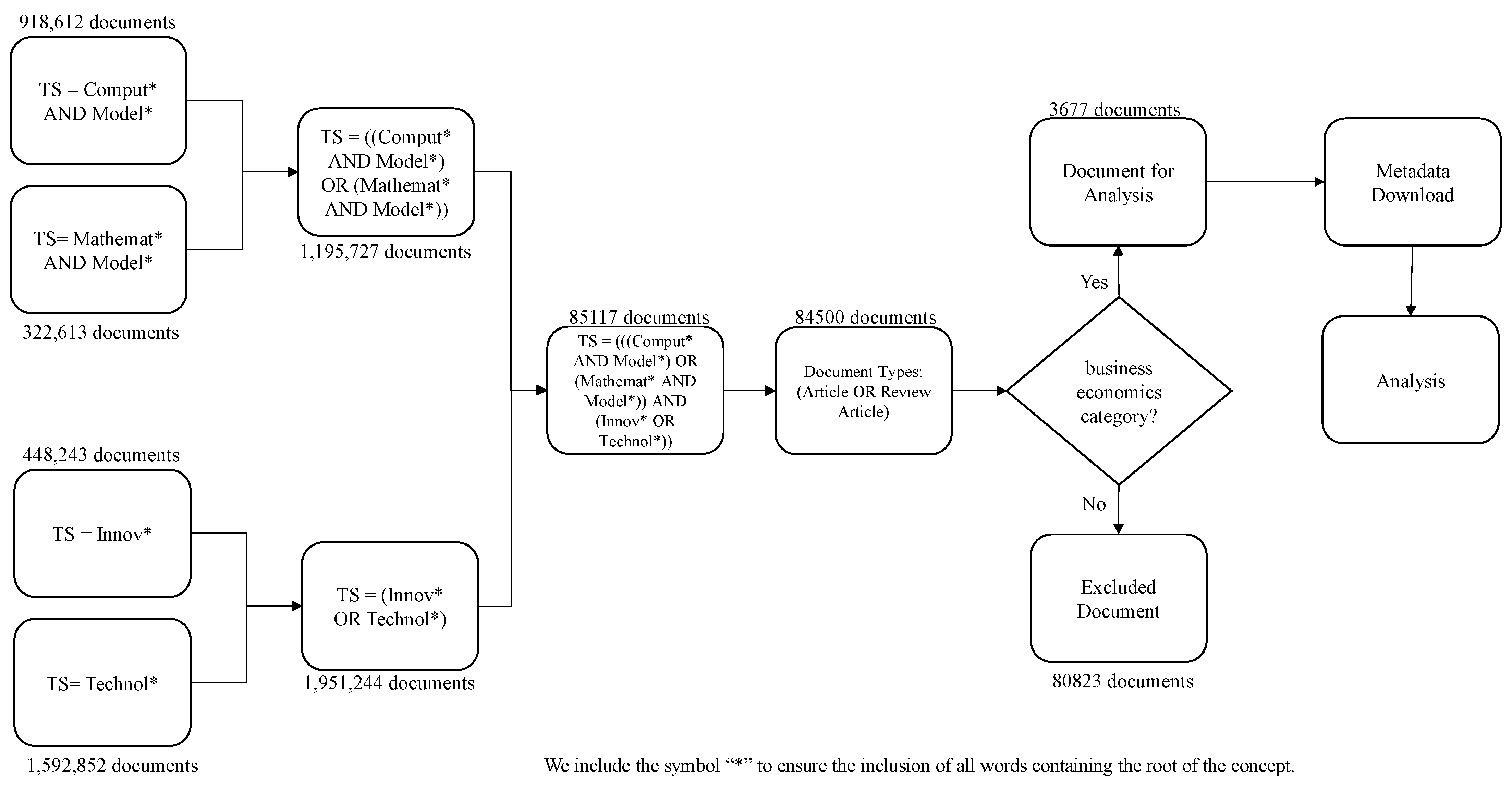
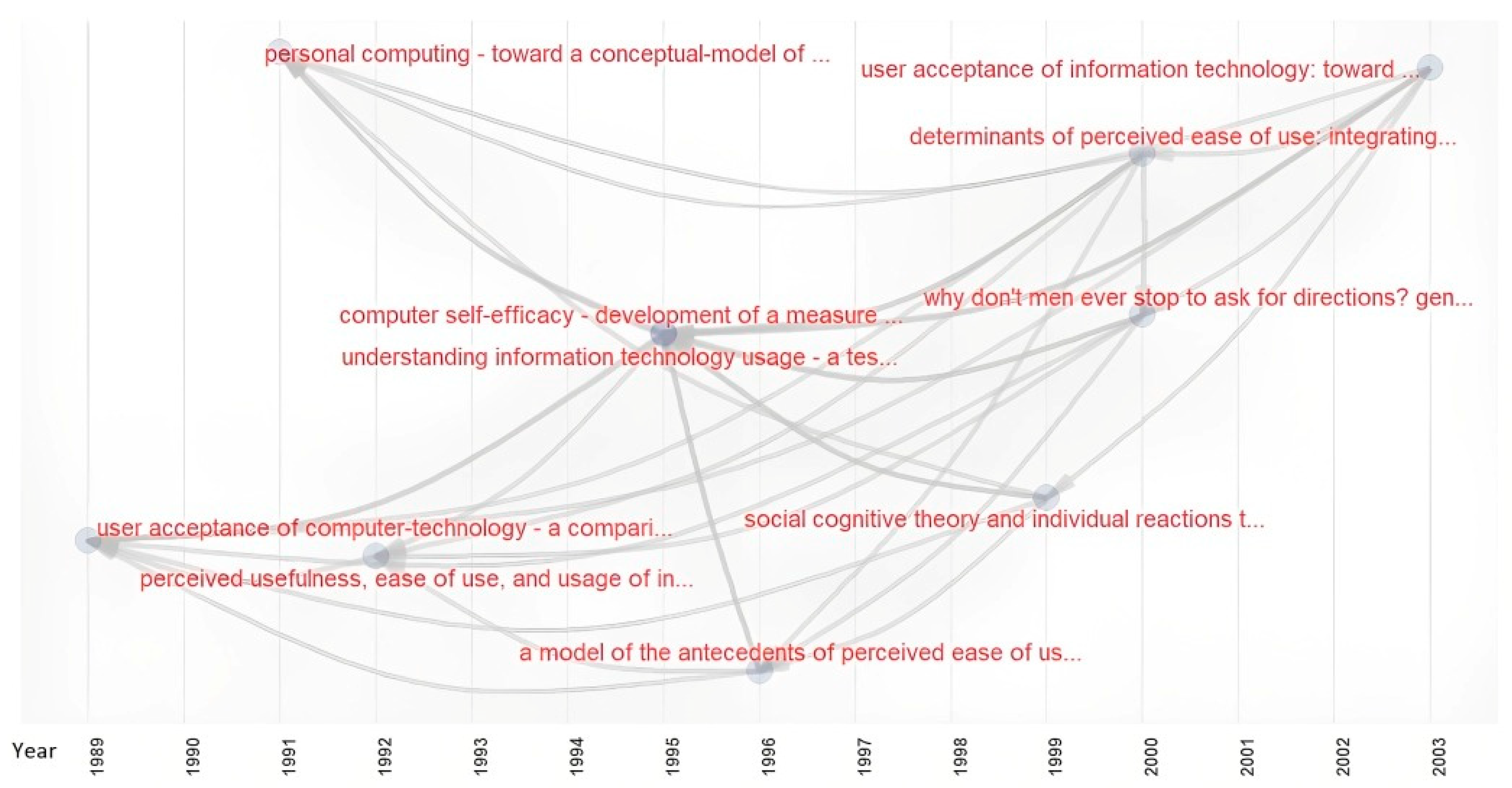
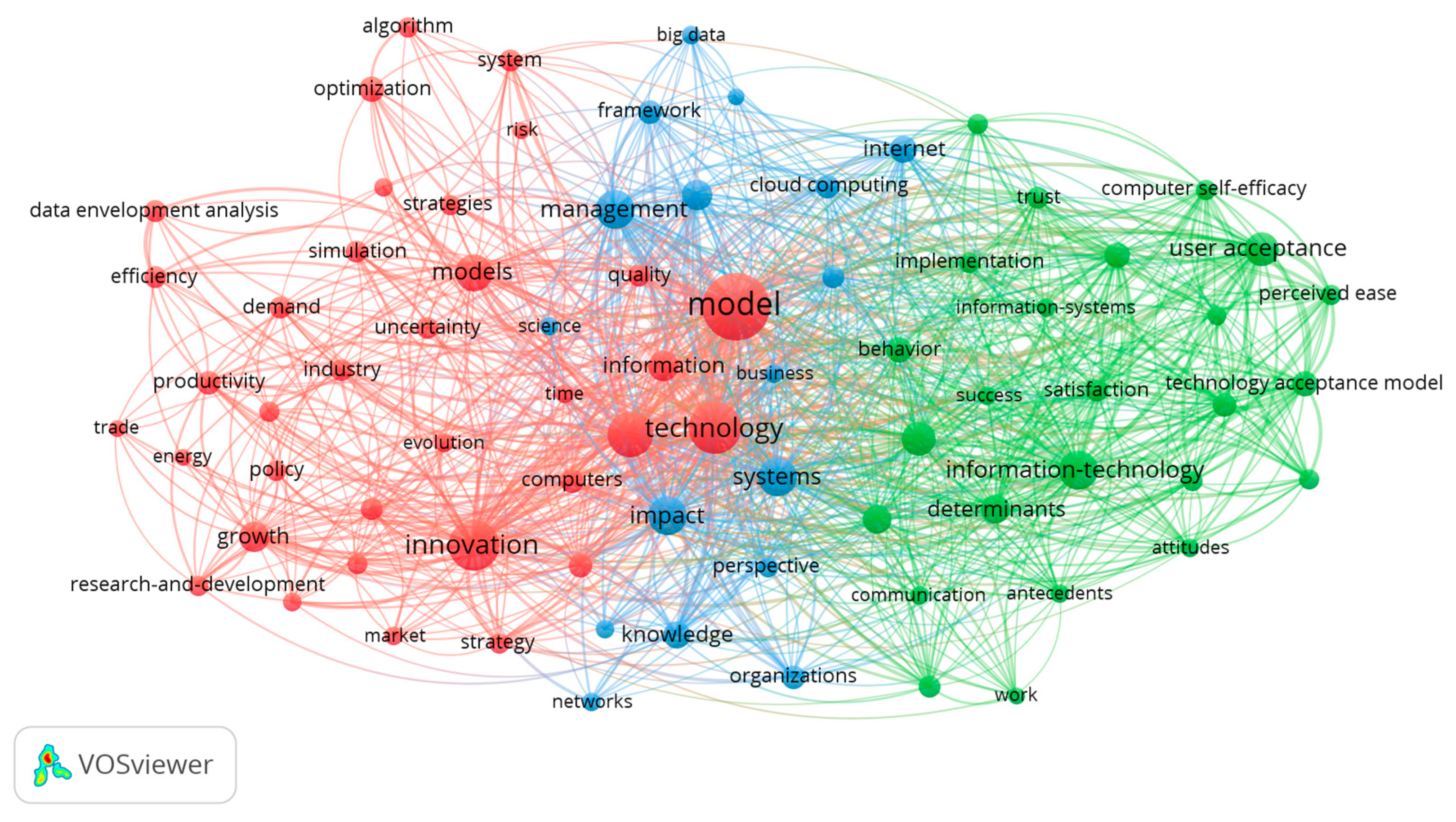

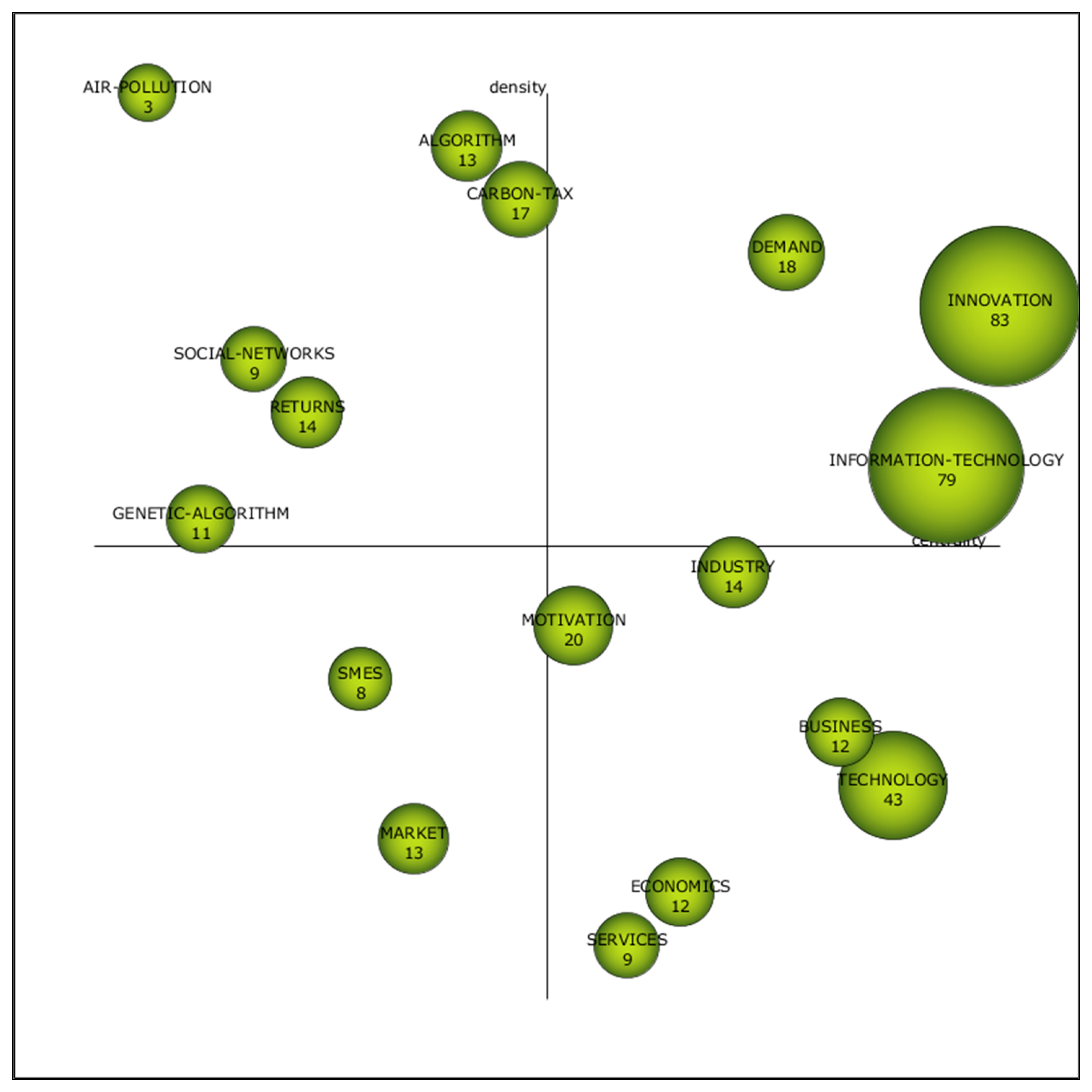

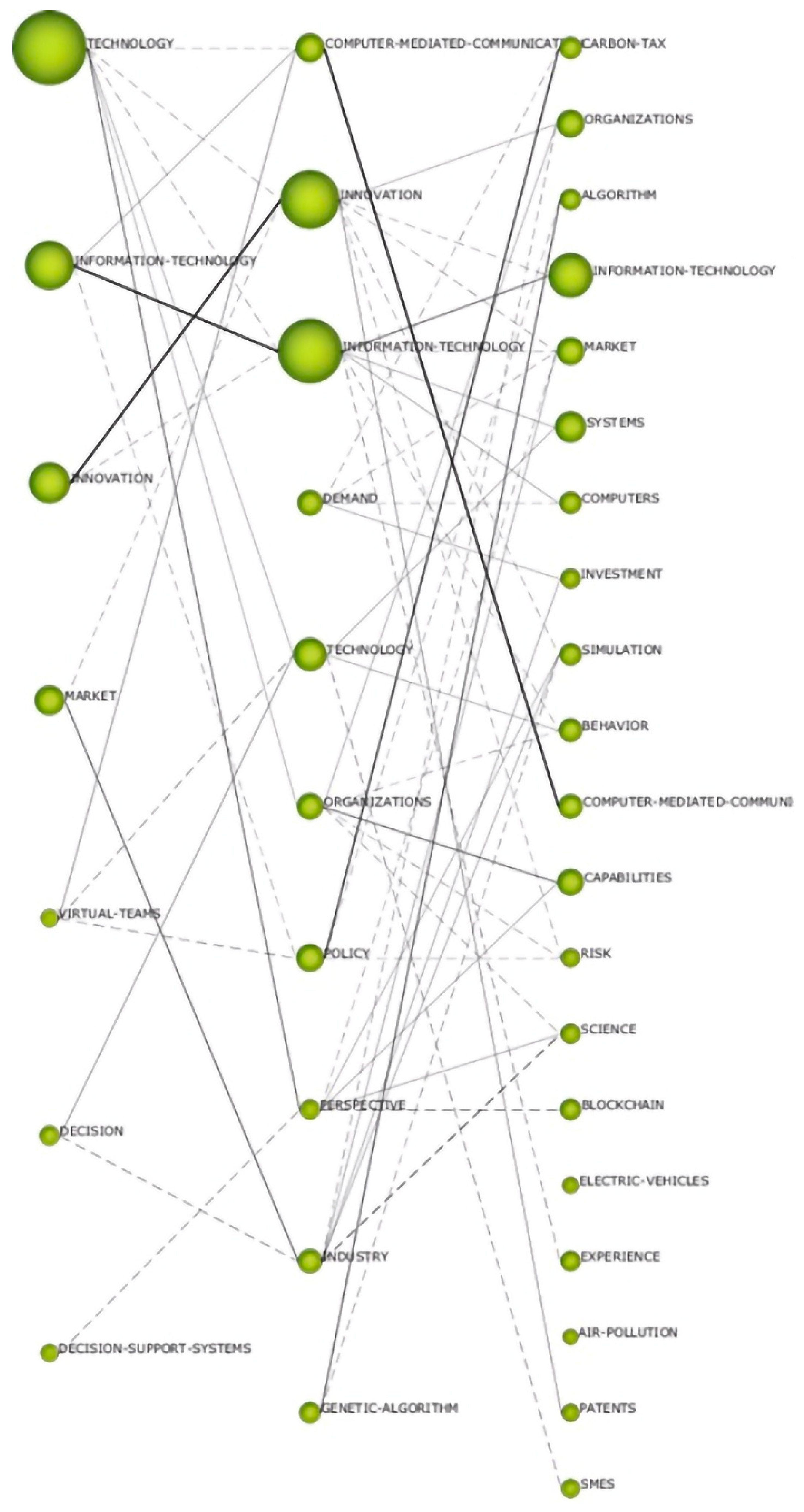
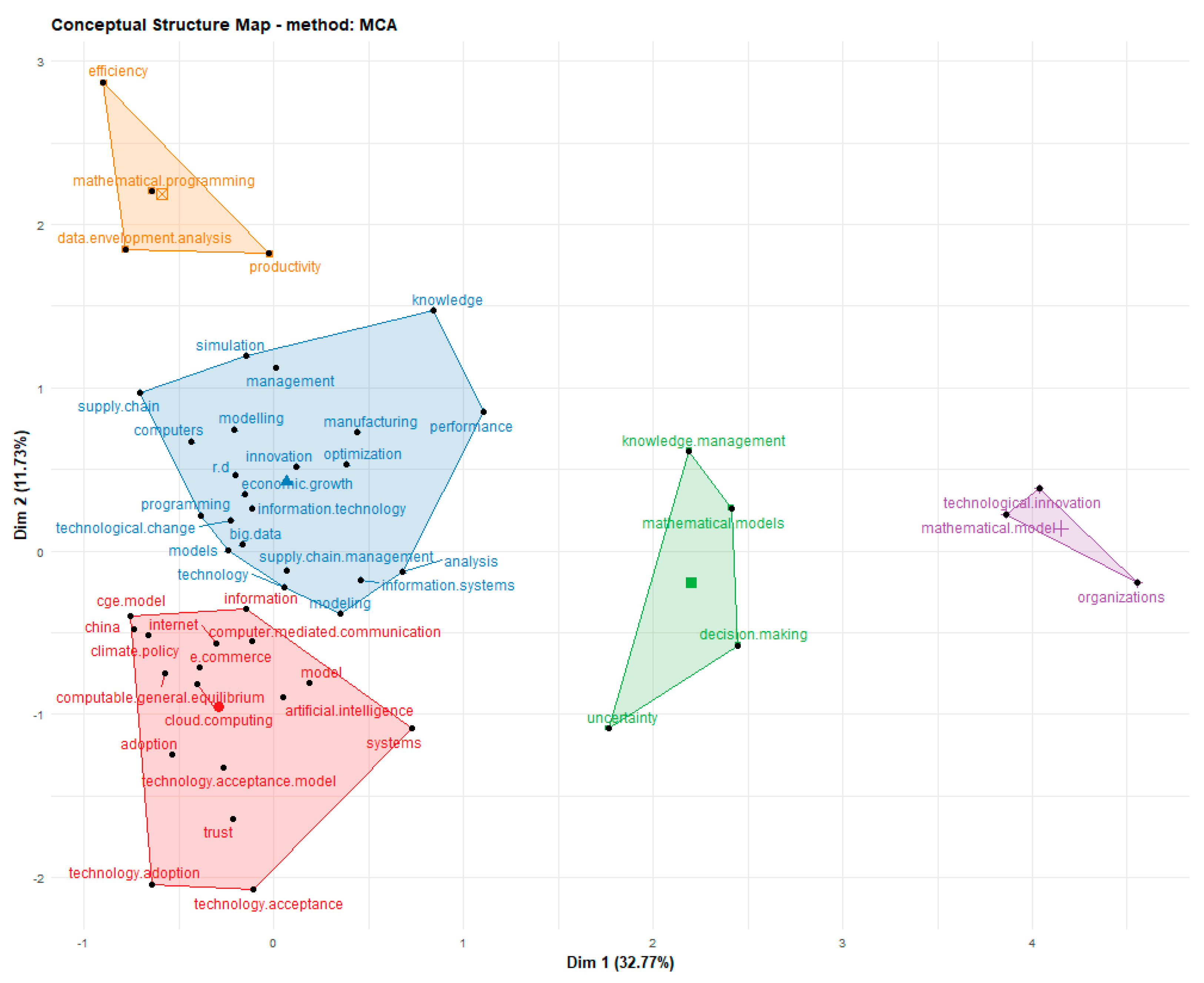
| Types of Indicators | Indicators |
|---|---|
| Activity indicators | Number of publications |
| Number of contributing authors | |
| Number of journals | |
| Number of countries | |
| Quality indicators | Total number of citations received |
| Average number of citations per publication | |
| Impact factor | |
| H-Index | |
| Relationship indicators | Co-citation |
| Bibliographic Coupling | |
| Co-word | |
| Co-authorship | |
| Degree of centrality |
| Theme | Centrality | Density | h-Index | Citations | Nodes | Docs |
|---|---|---|---|---|---|---|
| Innovation | 27.9 | 3.84 | 83 | 25,966 | Capabilities | 56 |
| Diffusion | 97 | |||||
| Firms | 85 | |||||
| Innovation | 430 | |||||
| Model | 929 | |||||
| Networks | 82 | |||||
| Organizations | 122 | |||||
| Patents | 20 | |||||
| Product | 45 | |||||
| Strategy | 139 | |||||
| Information Technology | 24.46 | 2.67 | 79 | 43,285 | Attitudes | 68 |
| Behavioral Intention | 23 | |||||
| Communication | 61 | |||||
| Computers | 139 | |||||
| Computer-Mediated Communication | 92 | |||||
| Determinants | 130 | |||||
| Impact | 267 | |||||
| Information Technology | 367 | |||||
| Social Influence | 20 | |||||
| Demand | 8.31 | 3.99 | 18 | 2638 | Demand | 84 |
| Elasticities | 12 | |||||
| Inequality | 37 | |||||
| Investment | 75 | |||||
| New-Product | 4 | |||||
| Personal-Computers | 18 | |||||
| Price | 53 | |||||
| Price-Indexes | 7 | |||||
| Task | 20 |
Disclaimer/Publisher’s Note: The statements, opinions and data contained in all publications are solely those of the individual author(s) and contributor(s) and not of MDPI and/or the editor(s). MDPI and/or the editor(s) disclaim responsibility for any injury to people or property resulting from any ideas, methods, instructions or products referred to in the content. |
© 2023 by the authors. Licensee MDPI, Basel, Switzerland. This article is an open access article distributed under the terms and conditions of the Creative Commons Attribution (CC BY) license (https://creativecommons.org/licenses/by/4.0/).
Share and Cite
Castillo-Vergara, M.; Muñoz-Cisterna, V.; Geldes, C.; Álvarez-Marín, A.; Soto-Marquez, M. Bibliometric Analysis of Computational and Mathematical Models of Innovation and Technology in Business. Axioms 2023, 12, 631. https://doi.org/10.3390/axioms12070631
Castillo-Vergara M, Muñoz-Cisterna V, Geldes C, Álvarez-Marín A, Soto-Marquez M. Bibliometric Analysis of Computational and Mathematical Models of Innovation and Technology in Business. Axioms. 2023; 12(7):631. https://doi.org/10.3390/axioms12070631
Chicago/Turabian StyleCastillo-Vergara, Mauricio, Víctor Muñoz-Cisterna, Cristian Geldes, Alejandro Álvarez-Marín, and Mónica Soto-Marquez. 2023. "Bibliometric Analysis of Computational and Mathematical Models of Innovation and Technology in Business" Axioms 12, no. 7: 631. https://doi.org/10.3390/axioms12070631
APA StyleCastillo-Vergara, M., Muñoz-Cisterna, V., Geldes, C., Álvarez-Marín, A., & Soto-Marquez, M. (2023). Bibliometric Analysis of Computational and Mathematical Models of Innovation and Technology in Business. Axioms, 12(7), 631. https://doi.org/10.3390/axioms12070631








